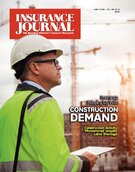While the labor market continues to come up short for the construction industry, the insurance market is doing its job supplying the coverages the industry needs to keep up with the significant demand for new building.
Despite the challenges finding qualified workers to keep pace with the demand for new building projects, construction is still booming, with overall spending up by 10% compared to a year ago, according to the Associated General Contractors Association.
As building continues, contractors are finding a more stable insurance market for most lines of coverage. Market corrections over the past several years have resulted in a more steady rate environment, leading to improved insurer-combined loss ratios throughout the construction industry, reports WTW in its Insurance Marketplace Realities 2024 Spring Update – Construction, released in May.
“We anticipate significant construction activity will continue through 2024,” said the WTW report, which noted infrastructure, renewable energy, industrial manufacturing and healthcare as areas of growth in the commercial construction world.
The construction industry boom in the U.S. is “phenomenal,” according to Darren Tasker, North American head of energy and construction at Allianz Commercial. “We’re seeing record number of submissions and activity.”
“The amount of backlog that some contractors have is tremendous, often in the billions of dollars of work,” he said. That means contractors can be selective on the types of jobs they choose, and so can their insurance partners, Tasker added.
“They can be selective on the projects that they feel will have the best opportunity to execute and have the highest margins,” he said. “It’s the same for us on the insurer side.”
Two exceptions to the good news may be the market for builders’ risk insurance, especially in catastrophe-prone areas, and excess liability market for high hazard risks.
Residential Builders Risk
Recent loss trends have led to a hard adjustment period for the builder’s risk market for residential construction and while the market is seeing some signs of improvement, high-cat prone areas remain extremely difficult.
Wood frame fire losses ranging both in size and geographic location exploded in 2023 compared to prior years with 16 different substantial fire losses totaling nearly $400 million, with the largest loss estimated right under a $100 million, according to a WTW estimation. The 2023 annual total of builder’s risk frame losses nearly doubled compared to 2022 and quadrupled compared to 2021, WTW said
Dudley Ray, managing director of Higginbotham’s Houston office, says builder’s risk rates for coastal Texas regions and the entire Dallas-Fort Worth area are still going up “quite substantially.” That’s with large increases in deductibles for wind and hail, he added. “And it is not getting any better, especially if it’s frame construction,” he said. “There are a lot of carriers that just won’t write over a certain limit if it’s frame so that is becoming a struggle and a challenge. Some contractors and the owners of properties are choosing to self-insure above certain limits.”
He sees the same trend for new homes built anywhere in the U.S. in wildfire prone regions. “There was a home that we were asked to insure, a second home, in Montana or Idaho … when the client and the home builder got the builder’s risk quotes, they decided to totally self-insure, and this house was over $25 million in value.”
Ray says there’s a void in the Texas market right now for builder’s risk, and property in general, when it comes to insuring homes in wind and fire regions. “Frame construction scares the underwriters, but it’s more cost effective for the builder,” he added.
Dudley hasn’t seen any new carriers enter the builder’s risk market in Texas but that’s not stopping the building boom.
“We’re just seeing builders taking larger deductibles and being a little more watchful of their product.” For example, some of his homebuilder clients will hire security services for after hours in an effort to be more proactive in protecting their product, he said.
So far, 2024 is seeing strong building growth in residential construction, he added. But it’s not just residential construction. “This is one of the first times I’ve seen in my career where almost every sector of construction is doing well,” he said. “Generally, in Texas, when oil and gas is up, construction’s down and vice versa. But right now, we’re seeing both doing well. We’re involved in oil and gas construction as well, and we see both sectors doing well,” he said. “Builders are still building a lot.”
Umbrella Liability and Excess Liability Market
The umbrella/excess market has steadily stabilized over the last few years, according to the WTW report. But challenges remain for high hazard risks, including contractors with large auto fleets, New York construction operations, for-sale residential, wood-frame construction, wildfire exposed utility work and trades that participate in demolition, and those contractors doing curtain wall and foundation work, the report noted. “Construction activities with these risk profiles will continue to see rate increases through their excess tower,” WTW said.
Another recent benchmark study on the construction insurance market released in April by Unison Risk Advisors, an Assurex Global partner, found that excess liability limits overall decreased compared to last year, likely due to substantial rate increases.
“While we expected excess liability rates to increase, we were surprised by the amount,” the study noted. The study found that the rate variance between construction specialties is driven by the perceived risk associated with the construction activity, but when premiums were compared to last year’s benchmark study, average rates and premiums increased substantially, regardless of the type of contractor.
The Assurex Global benchmark study included data from almost 1,500 construction companies of various sizes and specialties that are insured through 26 partner firms of Assurex Global, an exclusive, global partnership of independent agents and brokers.
“Several years ago, everybody wanted horizontal limits, the $2m/$4m and then stacking above that,” said Richard Savino, principal and managing partner, Broadfield Insurance. “And then the marketplace really had trouble and it started going back to the $1m/$2m you’d see more on projects plus whatever higher limits they wanted depending upon the project.”
Savino says he’s now seeing $2m/$4m “becoming more of a staple on a day-to-day basis” especially in the commercial world. And “I think part of that is because it’s not uncommon these days for claims to go through the first layer” of an umbrella with the rising costs of social inflation. That’s resulting in expensive first layer umbrella coverage for many contractors. “That first layer of excess coverage has become ungodly expensive and sometimes almost unavailable,” Savino said. It’s unaffordable for some smaller contactors, especially those in the New York City area, he said.
“For example, we have an electrical contractor that does small commercial work and residential work, and part of his job is to change bulbs in traffic lights. He doesn’t deal with the timing … he doesn’t deal with anything other than that part.” But recently, after being with the same carrier for a long time, the account was nonrenewed. “They wouldn’t keep him anymore and he was hard to place in the marketplace.” He previously had an excess liability policy for $800. “Now that coverage costs him $12,000.”
Opportunities
Infrastructure building continues to present opportunities as funds from the federal Infrastructure bill are being distributed. The Bipartisan Infrastructure Investment and Jobs Act, signed two years ago, promises to deliver more than $400 billion to infrastructure construction and fund some 400,000 projects.
“The first half of 2024, we’ve really started to see infrastructure start to pick up,” said Lyndsey Christofer, Chubb’s executive vice president of construction, real estate and hospitality. “We’re finally starting to see money from the infrastructure bill really trickle in, and we’re also starting to see some of those really large mega projects, in the pipeline.” Some have not come to market yet but they’re in the final bid stage, she added.
“That’s where a lot of the activity has been, as well as the sustained increase in chip facilities, manufacturing facilities, data centers, battery storage facilities,” she added. “That’s really where we’ve seen just an explosion of growth over the last two years.”
Christofer says she’s hopeful to see more activity in the second half of the year for the “typical building” such as in residential, condos, apartments, hotels, even commercial buildings.
“We’ve seen very little of that since end of summer last year once the interest rates really started to rise,” she said. “We’ve talked to a lot of developers that have said, ‘Listen, we have the money, we have the land; we’re just waiting because the interest rates are so high.’ It just doesn’t make sense at this point,” she added. “The infrastructure bill will continue to fuel the market for years to come at this point.”
Aldo Fucentese, senior vice president, construction practice leader at Liberty Mutual Insurance, also sees infrastructure continuing through 2024 and beyond but cited opportunities in K-12 schools, healthcare, manufacturing and data centers as well. While some sectors have slowed a bit, there’s still plenty of building everywhere, he said, and the cost of insurance is not going down.
“The cost of insurance is not going down in the US where we still have a lot of pressure on severity, and a lot of claims being litigated,” he said.
His advice to contractors and their agents and brokers – know your partners. “Know who you’re doing business with so if something goes wrong, they can call you back, then you can fix the problem rather than them suing you,” he said. “And manage your risks now.”
Topics Trends Construction
Was this article valuable?
Here are more articles you may enjoy.



 ‘Great Resignation’ Enters Third Year as Workers Embrace AI, Upskilling, PwC Says
‘Great Resignation’ Enters Third Year as Workers Embrace AI, Upskilling, PwC Says  QBE to Non-Renew $500M of North American Mid-Market Biz
QBE to Non-Renew $500M of North American Mid-Market Biz  Workers Sue Disney, Say They Were Wrongly Induced to Move to Florida
Workers Sue Disney, Say They Were Wrongly Induced to Move to Florida  Let Good Adjusters, Not Expensive Lawyers, Make the Difference on Claims, CEO Says
Let Good Adjusters, Not Expensive Lawyers, Make the Difference on Claims, CEO Says 



